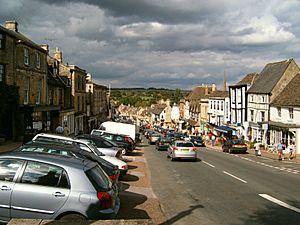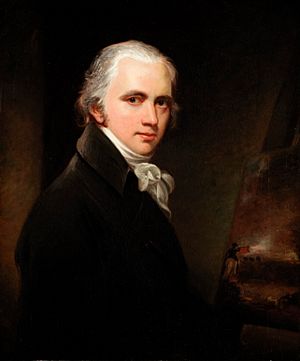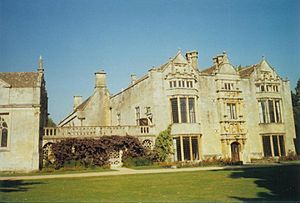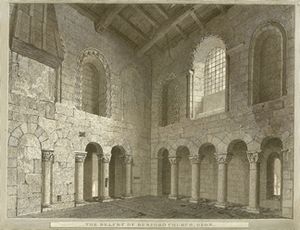Burford facts for kids
Quick facts for kids Burford |
|
|---|---|
 Looking north along 'The Hill' |
|
| Population | 1,422 (parish, 2011 Census) |
| OS grid reference | SP2512 |
| Civil parish |
|
| District |
|
| Shire county | |
| Region | |
| Country | England |
| Sovereign state | United Kingdom |
| Post town | Burford |
| Postcode district | OX18 |
| Dialling code | 01993 |
| Police | Thames Valley |
| Fire | Oxfordshire |
| Ambulance | South Central |
| EU Parliament | South East England |
| UK Parliament |
|
| Website | Burford Town Council |
Burford is a historic town in the Cotswolds hills, in Oxfordshire, England. It sits by the River Windrush. People often call it the 'gateway' to the Cotswolds. Burford is about 18 miles west of Oxford. It is also about 22 miles southeast of Cheltenham. The town's name comes from old English words. Burh means a fortified town or hilltown. Ford means a place to cross a river. In 2011, about 1,422 people lived in Burford parish.
Contents
Burford's History and Life
Early Beginnings
The town of Burford started in the middle of the Saxon period. A small village was first built near where the modern priory stands today. This village was used until after the Norman Conquest of England. Then, the new town of Burford was built. A hospital was later built on the old village site. It stayed open until King Henry VIII closed many monasteries. The current priory building was built around 1580.
The Church of St John the Baptist
The most important building in Burford's town centre is the Church of St John the Baptist. It is a Church of England parish church. This church is famous for its special chapel built by merchants. It also has a memorial to Edmund Harman, who was King Henry VIII's barber-surgeon. This memorial shows South American Indians.
In 1649, during the English Civil War, the church was used as a prison. Soldiers from the New Model Army who had mutinied were held there. Some of the 340 prisoners carved messages and pictures on the church walls. These carvings can still be seen today.
Wool Trade and Tolsey Museum
Burford's town centre also has many houses from the 1400s. There is also a beautiful Baroque-style townhouse, which is now the Burford Methodist Church. From the 1300s to the 1600s, Burford was very important for its wool trade.
The Tolsey is a building in the middle of Burford's High Street. It was once the main place for trading goods. Today, it is a museum where you can learn about the town's history.
Burford Priory
Burford Priory is a large country house. It stands where an old hospital priory from the 1200s used to be. In the 1580s, an Elizabethan house was built using parts of the old building. It was later changed in the Jacobean style. This was probably after 1637, when William Lenthall bought the estate. He was the Speaker of the House of Commons during the Long Parliament.
From 1949, Burford Priory was home to a group of Church of England nuns. Later, it became a mixed community of nuns and monks. In 2008, the community moved, and the priory was sold. It is now a private home. In 2010, a TV show called Time Team dug at the Priory. They found old pottery pieces from the 1100s or 1200s.
The Banbury Mutiny
On May 17, 1649, three soldiers were executed in Burford churchyard. This happened because they were part of a mutiny. The soldiers, called Levellers, were upset about their pay. They also did not want to be sent to fight in Ireland. Oliver Cromwell ordered their execution. Corporal Church, Private Perkins, and Cornet Thompson were shot against the churchyard wall. The other soldiers were pardoned. Every year, people remember this event on 'Levellers Day'.
Bell Foundries in Burford
Burford has had bell foundries twice in its history. A bell foundry is a place where church bells are made. The Neale family ran one in the 1600s. Later, the Bond family ran another in the 1800s and 1900s. Many bells made by these families are still used in churches today. Some old Neale bells are even displayed in Burford parish church.
The Easter Synod
For many years, there was a disagreement about when to celebrate Easter Day. This was between the Celtic Church and the Early Church. A meeting was held in Burford in 685 to try and solve this problem. Important people attended this meeting. These included Æthelred, King of Mercia, and Theodore, the Archbishop of Canterbury. At this meeting, a monk named Aldhelm was asked to write a book about the Easter date issue.
Battle of Burford and the Golden Dragon
Historians record a battle that happened at Burford in 752. This was a fight between the West Saxons and the Mercians. The West Saxons were led by King Cuthred. The Mercians were led by King Æthelbald. The West Saxons won the battle. The Mercian standard-bearer, who carried a flag with a golden dragon, was killed.
The golden dragon standard is thought to come from Uther Pendragon, who was King Arthur's father. He was said to have two golden dragons made. One was given to a church, and the other he kept for his wars.
In the late 1500s or early 1600s, people in Burford still celebrated the battle. They would make a large dragon every year. They carried it through the streets with great joy on St. John's Eve. The field where the battle is believed to have happened is still called Battle Edge. In 1814, a large stone coffin was found near Battle Edge. It contained human remains, possibly from a warrior. This coffin is now kept in Burford churchyard.
What to Do in Burford
Burford has a primary school called Burford County Primary School. Burford School is the town's secondary school. Every summer, the primary school has a fair. It includes a parade with a dragon that goes down High Street. The Blue Cross animal charity has its main office in Burford.
In 2001, Burford became twinned with Potenza Picena. This is a small town in Italy. In 2009, Forbes magazine listed Burford as one of "Europe's Most Idyllic Places To Live."
News and Media
Local news for Burford comes from BBC South and ITV Meridian. You can also listen to local radio stations like BBC Radio Oxford and Heart South. The town's local newspapers are the Oxfordshire Guardian and Witney Gazette. The Bridge Magazine is a local community magazine for Burford and nearby villages.
Local Stories and Books
There is a local legend about a fiery coach in Burford. It is said to carry the ghost of Sir Lawrence Tanfield and his wife. They were known to be very harsh to their tenants. People say that seeing the coach brings a curse. Some stories say that local clergymen trapped Lady Tanfield's ghost in a corked bottle. They then threw it into the River Windrush. During dry times, locals would fill the river with buckets. This was to make sure the bottle did not rise and free the spirit.
Burford is the main setting for The Wool-Pack. This is a historical novel written for children by Cynthia Harnett. The author J. Meade Falkner, who wrote Moonfleet, is buried in Burford churchyard.
Famous People from Burford

- Elizabeth Cary, Viscountess Falkland (1585–1639), a poet and writer.
- William Lenthall (1591–1662), a politician who was Speaker of the House of Commons.
- Peter Heylyn (1599–1662), a church leader and writer.
- Lucius Cary, 2nd Viscount Falkland (c.1610–1643), an author and politician.
- Marchamont Nedham (1620–1678), a journalist and writer during the English Civil War.
- Christopher Kempster (1627–1715), a master stonemason and architect.
- William Beechey (1753–1839), a famous portrait painter.
- Katharine Mary Briggs (1898–1980), a folklorist and writer who lived in Burford.
|
See also
 In Spanish: Burford para niños
In Spanish: Burford para niños





